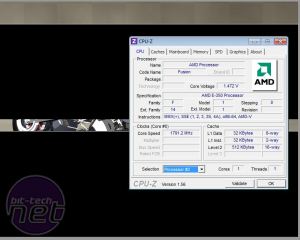GA-E350N-USB3: Overclocking
Gigabyte sent us the board with its F1 BIOS, which includes a few overclocking options, but we don't know how these stack up before we can compare them with other boards.It looks as though AMD has tied the CPU and memory controller closely together, as the single HyperTransport clock adjusts everything: CPU, memory and we suspect PCI-E as well. Thankfully, the Gigabyte BIOS allowed us to tweak the voltage adjustment for each of these, although we couldn't play with the CPU-NB or PCI-E clock as we could with a normal Phenom II or Athlon II system. The HyperTransport clock is also limited to meagre 120MHz, and even this was too much for it to handle after it had booted into Windows. However, this isn't really surprising, given that this embedded APU wasn't designed with overclocking in mind.
Even so, you still get plenty of flexibility with the voltage settings. You can pump up to +0.6V through the CPU (1.9V total) and CPU-NB (1.5625V total), while the FCH's voltage can be increased from 1.1V to 1.6V, the PCI-E PLL from 1.8V to 2.2V and the DDR3 voltage all the way up to 2.1V. Naturally, these settings flash red to warn you of your impending doom.
 After throwing on a hefty 2,000RPM 120mm fan, and increasing the voltages to +0.125V (1.425V total) for the CPU core and +0.15V (1.125V total) for the CPU-NB, the small heatsink had a sweaty temperature of 55oC underneath. At these settings, we could run the HT bus at 112MHz HT, giving us a 1,792MHz CPU and 1,492MHz memory clock. With 1.5V applied to the CPU we could increase the HT speed to 114MHz HT, giving us a 1,824MHz CPU clock speed, but this presented us with stability problems in some benchmarks.
After throwing on a hefty 2,000RPM 120mm fan, and increasing the voltages to +0.125V (1.425V total) for the CPU core and +0.15V (1.125V total) for the CPU-NB, the small heatsink had a sweaty temperature of 55oC underneath. At these settings, we could run the HT bus at 112MHz HT, giving us a 1,792MHz CPU and 1,492MHz memory clock. With 1.5V applied to the CPU we could increase the HT speed to 114MHz HT, giving us a 1,824MHz CPU clock speed, but this presented us with stability problems in some benchmarks.You can adjust the frequency of the GPU portion independently too, although we don't think this option currently works in the Gigabyte BIOS. We could set the GPU portion at its limit of 2,000MHz and the board would still boot, load Windows and play games, but with no appreciable increase in performance.
Once you add the fact that the USB 3 ports switched off as soon as we started overclocking, you can see that Gigabyte still needs to do some work in this area.
For you underclockers, it's also worth noting that the CPU and CPU-NB voltages can also be turned down by the same amount, and the DDR3 voltage goes as low as 1.2V to accommodate super-low voltage DIMMs. All this gives you plenty of room for you to tweak your machine into the lowest possible power footprint.

MSI MPG Velox 100R Chassis Review
October 14 2021 | 15:04









Want to comment? Please log in.